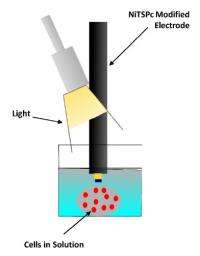November 29, 2012 feature
Communication channel between cells and machines paves way toward bio-hybrid robots

(Phys.org)—While some advanced humanoid robots already look eerily lifelike, robots in the future may actually become partly alive. Currently, researchers are working on integrating living cells and other biological components with electronic components in an attempt to create bio-hybrid robots. These robots could act autonomously, imitate some animal behaviors, and have the ability to self-replicate some of their parts.
One of the major challenges in developing bio-hybrid robots consists of creating an interface to allow communication between the biological and electronic components. This task is inherently difficult because the vast majority of cellular signals are simply not compatible with electronics. Most cellular processes use signals that travel too slowly to interface with electrical signals, and exposure to electrical charges has negative effects on many cells, which can lead to cell death.
Despite these challenges, a team of researchers, Orr Yarkoni, Lynn Donlon, and Daniel Frankel from the Department of Chemical Engineering at Newcastle University in the UK, has developed a way to make communication between these two domains possible. In their study, the researchers genetically engineered protein cells from a Chinese hamster ovary to produce nitric oxide in response to visible light. When the mutant cells were coupled to a platinum electrode, the resulting device could convert an incoming optical signal to a chemical signal, which could then be converted into an electrical signal. This signal transduction pathway provides an important step in developing future bio-hybrid robots.
"The bio-electronic interface is notoriously difficult to manipulate," Frankel told Phys.org. "Usually the electronics are modified to fit the biological system of interest with limited success. This is the first time that we have tried an alternative approach, to modify the biology (via genetic engineering) to fit the electronics."
One of the keys to opening a communication channel was identifying nitric oxide as a suitable chemical compound for the middle signal in the pathway. As the researchers explained, nitric oxide is one of the few compounds that meets all the requirements for this role: it can permeate cells, is highly diffusible, has a relatively short half-life, and is one of the rare cell signaling molecules that remains in its gaseous form in any cell environment. As an indication of its aptitude for signaling, nitric oxide is widely used in nature, playing a role in areas such as muscle relaxation, blood vessel widening (vasodilation), inadequate blood flow (ischaemia), penile erection, and stroke.
Several proteins naturally produce nitric oxide in response to a chemical stimulus, but the researchers wanted to produce nitric oxide in larger amounts and in response to an optical stimulus. To achieve this, the researchers explained how they were able to "hijack" the protein's electron transfer pathway by severing a particular gene coding for a binding site required by the native pathway. In addition to removing that binding site, the researchers inserted amino acid structures called light-oxygen-voltage (LOV) domains into one or two regions in the protein. Since these structures are capable of accepting an electron from an incoming photon, they make the protein produce nitric oxide in response to light.
In experiments, the researchers observed that mutant cells that were modified with LOV domains produced more nitric oxide than the wildtype cells when exposed to light. Increasing the light stimulus further increased the mutant cells' nitric oxide production, while the wildtype cells exhibited limited photosensitivity. The researchers also found that mutant cells with two LOV domains produced about twice as much nitric oxide as those with only one LOV domain.
When coupled to an electrode, the mutant cells could produce sufficient nitric oxide to cause a change in the electrode's current. By changing the light intensity, the researchers could control the communication signals traveling through this optical-chemical-electrical cascade. Unlike typical solid-state photodetectors, these devices have the ability to self-reproduce and the potential to combine input signals to perform computation. These advantages could be turned into useful applications in a future generation of advanced robots.
"This work is part of a bigger project to build a swimming bio-hybrid robot called 'Cyberplasm,'" Frankel said. "These cells are the 'eyes' of the robot able to respond to light and tell the robot to alter its swimming pattern in response. The complete robot is still in development, but we are working on the individual parts. Potential applications are robots that can swim into contaminated areas, detect chemicals and report back."
Co-investigators of the Cyberplasm project are Joseph Ayers at Northeastern University in Boston, Chris Voigt at MIT, and Vlad Parpura at the University of Alabama.
The next step for the researchers is to produce cells that can communicate with electronics in response to chemical stimuli, and in addition communicate with each other.
More information: Orr Yarkoni, Lynn Donlon, and Daniel Frankel. "Creating a bio-hybrid signal transduction pathway: opening a new channel of communication between cells and machines." Bioinspir. Biomim. 7 (2012) 046017 (7pp). DOI: 10.1088/1748-3182/7/4/046017
Copyright 2012 Phys.org
All rights reserved. This material may not be published, broadcast, rewritten or redistributed in whole or part without the express written permission of PhysOrg.com.















